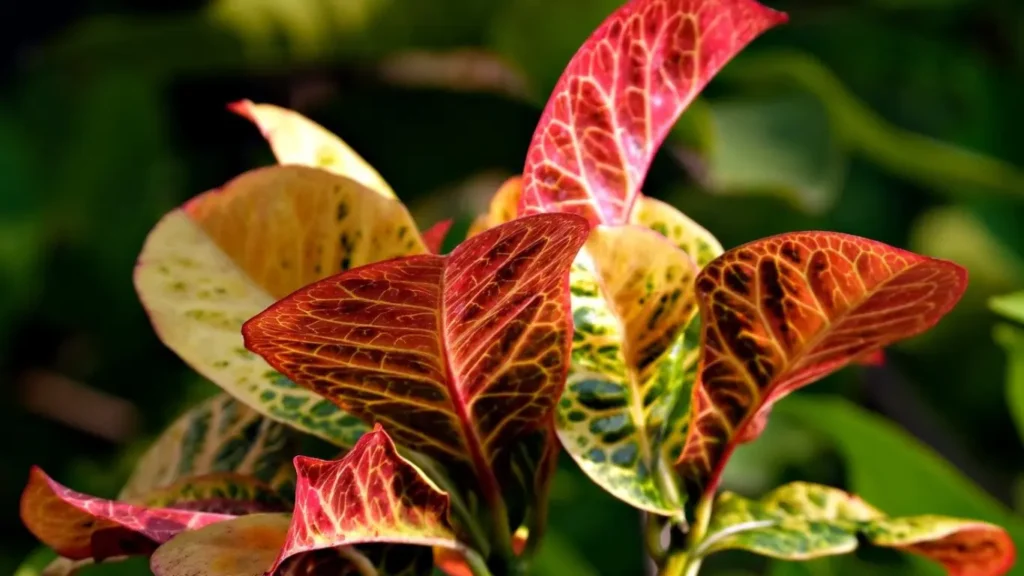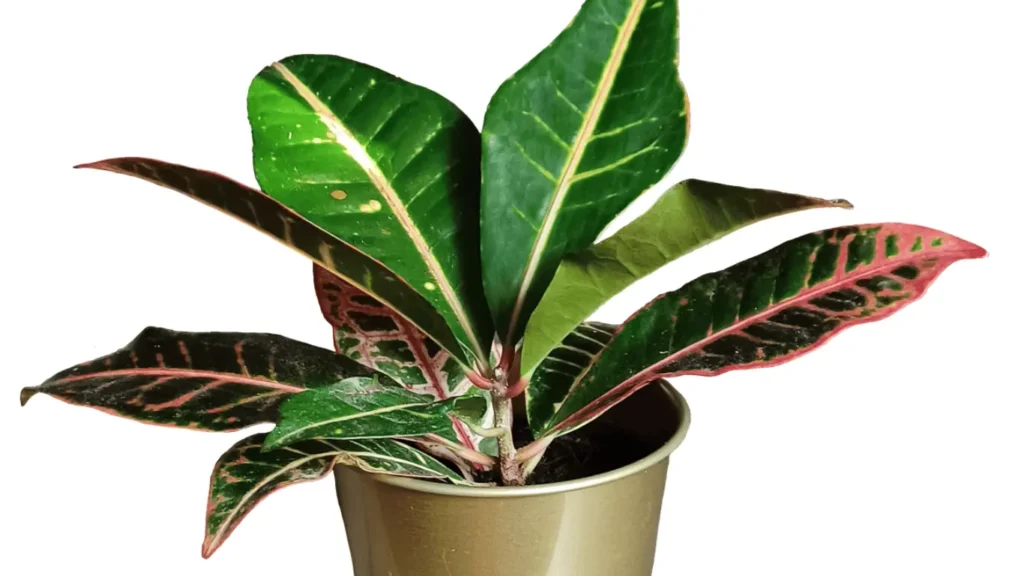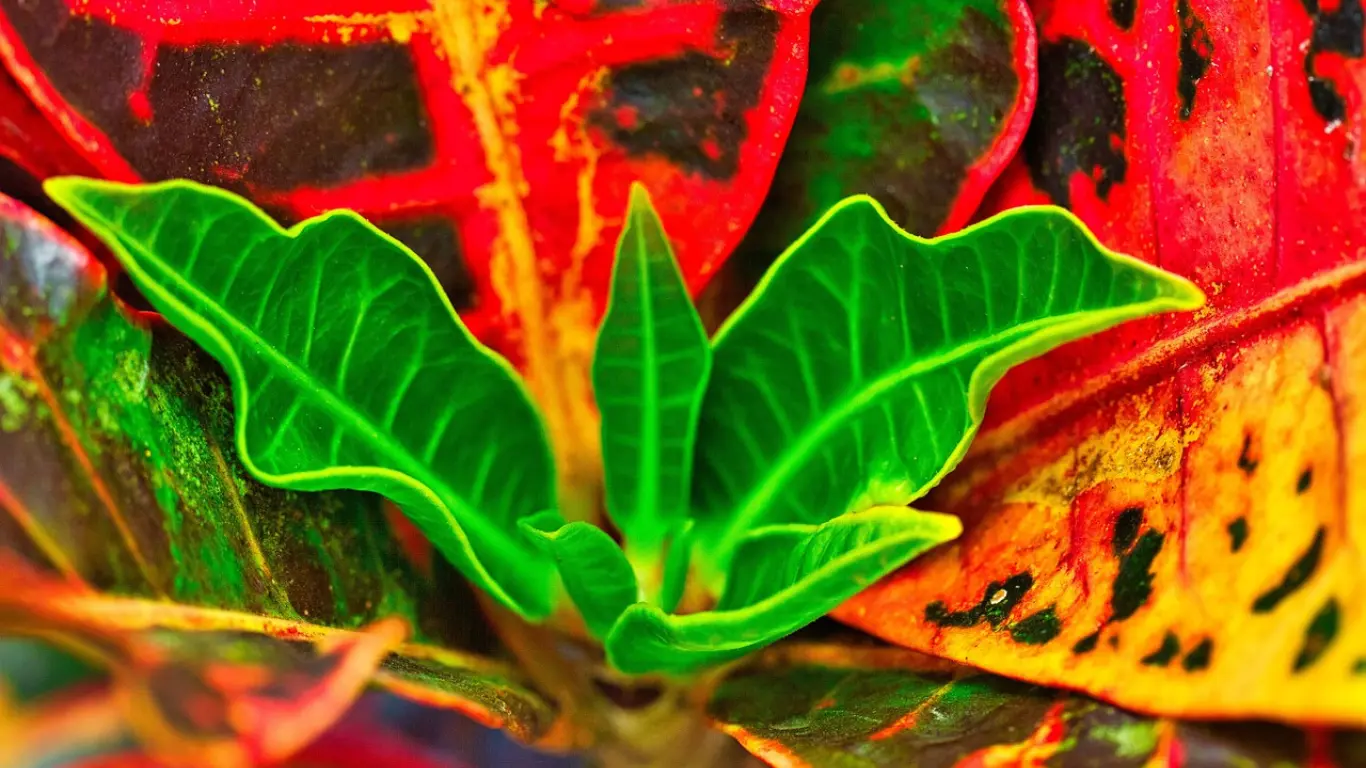Seeing lush, colorful leaves can lift your mood. The croton mammy does just that, adding tropical beauty to your space. It makes your home feel alive.
This bold plant welcomes you every day, like a ray of sunshine on a beach. It starts conversations, adds depth to your decor, and turns any room into a vibrant retreat.
Table of Contents
What Makes the Croton Mammy Plant Unique?
The Croton Mammy has narrow, twisting leaves in bold red, yellow, and orange. Each curl shows a bit of green, making it a standout. It thrives in warm, humid environments, just like its tropical home.
This plant is perfect for small spaces. It adds color and texture, making any area feel like a tropical paradise. Its unique look is admired by many for its ability to enhance any room without being too much.
“Its balanced size and multi-hued leaves bring tropical energy into any interior,” notes a local gardening expert.
The Mammy Croton loves warm temperatures. It shows off its vibrant colors when it’s happy and healthy.
Ideal Indoor Growing Conditions for Mammy Croton
Your mammy croton loves steady warmth, bright light, and enough moisture. To make it happy, balance these elements. This way, its leaves stay bright and new growth is steady.
Light Requirements
Put your plant near a window with filtered sunlight. Direct sunlight can burn its leaves. So, a spot with soft, dappled light is perfect.
Temperature and Humidity
Keep the temperature between 70–80°F for your mammy croton. This warmth helps it grow well. Also, keep the air moist to prevent dry leaves. A humidifier or pebble tray can help.
Watering Guidelines
Water your soil when it feels a bit dry. Don’t let the pot sit in water, as it can harm the roots. The right amount of moisture encourages healthy growth.
Step-by-Step Croton Mammy Care
Guide your Mammy Croton plant through each growth phase. Make sure it has the right foundation and a steady schedule. Healthy foliage comes from balanced soil and gentle daily care.
Soil and Fertilizer
A well-draining, peat-based potting mix is key. It lets roots breathe and prevents rot. A slow-release, balanced fertilizer keeps leaves vibrant with steady nutrients.
Routine Maintenance
Consistency is important for a strong plant. Clean leaves to let light in and rotate the pot for even growth. Trimming dead leaves helps the plant focus on growing strong.
Keep watering and feeding regular. Your croton mammy plant will thank you with vibrant colors all year.
Common Challenges with Mammy Croton Plant
Even with careful upkeep, your mammy croton plant may face a few setbacks. Leaf drop or drooping often occurs if watering habits fluctuate, so keep a consistent schedule. Yellow or faded foliage might suggest a lack of sunlight. Temperature dips can shock delicate leaves. Watch closely for any sudden changes that signal your plant’s discomfort.
Pests can create headaches. Spider mites, mealybugs, and scale insects hide along stems and undersides of leaves. A swift response is vital. Inspect surfaces and remove intruders with mild solutions. Stay alert to signs of sticky residue or fine webbing. Early detection helps protect your mammy croton plant from ongoing damage. Keep conditions stable, and you’ll maintain its vibrant tropical allure with ease.
Enhancing Your Décor with Houseplants
Vibrant leaves and bold shapes can make any room come alive. Try placing bright pots near windows or on side tables for a stunning look. This adds color to neutral furniture and keeps your space lively and welcoming.
Coordinating Colors and Textures
Pair large-leaf plants with slender ones for fun contrasts. Mix bright greens, reds, or oranges with soft walls or backgrounds. This makes your space feel lively and inviting.
Creating a Tropical Focal Point
Place a lush plant near a bright window or on a stylish stand. It becomes the centerpiece of your living area. The vibrant colors draw attention, making the rest of your decor simple yet effective. This adds a tropical vibe to any room, from your home office to your cozy den.
Propagation and Pruning for Croton Mammy Plant
Want to grow more mammy croton plants? Start by taking healthy stem cuttings during the plant’s active season. Cut a piece with enough leaf nodes. Then, put it in a mix of peat and perlite.
Keep it warm and humid to help roots grow. Make sure the soil stays moist but not too wet.
Pruning keeps your mammy croton looking good. Use clean shears to cut off long or damaged branches. This helps the plant focus on growing new leaves.
Prune every few months to keep it healthy and full. This way, your mammy croton will stay a beautiful part of your indoor garden.

Positioning Your Mammy Croton for Optimal Growth
Choosing the right spot is key for a healthy plant. Your Mammy Croton plant loves bright, filtered light. This keeps its colors bright and lively.
Indoor Placement
Make sure it’s not too close to direct sunlight. A spot with gentle light is best for strong growth. Use curtains or blinds to block strong midday sun.
This helps prevent leaf burn and keeps your plant looking great.
Balancing Light and Space
Give your plant enough room for air to move. Too little space can cause leaves to lean or spread unevenly. Turn the pot every few weeks to ensure even lighting.
This helps your Mammy Croton plant grow evenly and stay vibrant from all sides.
Seasonal Tips for Croton Mammy Care
Adjust your care routine with the seasons. In warm weather, add a bit of humidity and mist your plant now and then. If the top inch of soil feels dry, water more often.

In colder months, keep your plant away from drafts. Also, water less to avoid root problems. If growth slows, wait until spring to fertilize. This helps your mammy croton plant stay happy all year.
“Better Homes & Gardens recommends limiting fertilizer during cooler seasons to accommodate reduced growth rates.”
Check your plant monthly for signs of trouble. Look for dry or brown leaves. Remove any damaged leaves to promote new growth. This keeps your plant stable and ready for temperature changes.
- Watch for soil dryness in hot weather
- Reduce watering in cooler months
- Avoid exposing foliage to sudden cold drafts
Conclusion
Creating a regular care routine for your Mammy Croton turns your home into a vibrant oasis. Bright windows and gentle humidity keep the leaves looking fresh. This care prevents leaves from falling off and keeps pests away.
Make sure the soil drains well and fertilize moderately. This helps your plant stay colorful. You can also learn how to repot your Croton Mammy to keep the roots healthy. This care makes your plant’s leaves stand out.
Your hard work in caring for your Mammy Croton brings a tropical vibe to your space. Every time you walk into the room, you’ll see a burst of color. With patience and attention, you’ll enjoy every new leaf that grows.

